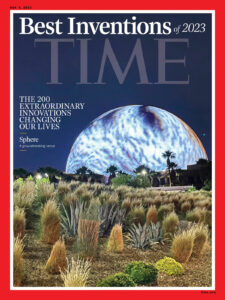CENIC Awards AI Fire-Detection Tool an “Innovations in Networking” Award for Innovations in Public Safety
The award recognizes exemplary people, projects, and organizations that leverage high-bandwidth networking
- March 14, 2024

The Corporation for Education Network Initiatives in California (CENIC) named an AI fire-detection tool created by the University of California San Diego’s ALERTCalifornia program, the California Department of Forestry and Fire Protection (CAL FIRE), and industry partner DigitalPath the winner of the 2024 Innovations in Networking Award for Innovation in Public Safety.
Launched in summer 2023, the AI system provides early wildfire confirmation and actionable real-time data to quickly scale fire resources, support evacuations through enhanced situational awareness, and monitor fire behavior. The AI platform is a new tool in the toolbox and allows data to drive firefighting decisions, which saves lives and protects biohabitats and infrastructure. The AI quickly became an important tool for CAL FIRE, and is currently used at all 21 Dispatch Centers across the state. It is especially effective in spotting anomalies in remote locations and has proven effective at night, even alerting firefighters to potential incidents before 911 calls.
“The cameras and AI are revolutionizing wildfire detection, providing invaluable early warnings in both non and densely populated regions,” said CAL FIRE Staff Chief of Intelligence Philip SeLegue. “By swiftly identifying fires many times before initial emergency reports, these advanced systems are not just technology, they assist in our mission to suppress 95% of fire 10 acres or less. Every second counts in wildfire response, and ALERTCalifornia’s cameras and the AI are proving to be indispensable guardians of our communities’ safety.”
The AI assimilates image data from over 1,060 cameras provided by ALERTCalifornia’s extensive network, enabling the effective monitoring and identification of potential incidents. This system is supported by UC San Diego’s advanced wireless network and builds upon the university’s partnership project High Performance Wireless Research and Education Network (HPWREN). HPWREN also received a CENIC award in 2018. Today, ALERTCalifornia’s team bridges disciplines and includes researchers from Scripps Institution of Oceanography, Jacobs School of Engineering, and the Qualcomm Institute. The program’s integrated system allows stakeholders real-time access to ALERTCalifornia’s images and the ability to view time-lapse histories, significantly enhancing situational awareness and decision-making capabilities.
“ALERTCalifornia, CAL FIRE, and DigitalPath are very proud to be the recipients of the 2024 CENIC award in recognition of network innovations for public safety,” said Neal Driscoll, ALERTCalifornia director and professor of geology and geophysics at Scripps Institution of Oceanography at UC San Diego. “We have employed high-bandwidth networking to provide new tools in the toolbox and allow data to drive firefighting decisions, which saves lives and protects biohabitats and infrastructure.”
When the AI spots a potential fire, the system alerts firefighters and provides a percentage of certainty and estimated location for the incident. If the incident is vetted and confirmed by trained watchstanders, firefighters respond quickly to extinguish the fire at the incipient phase. This system excels due to the expertise brought by each partner.
“Our collaborative partnerships with UC San Diego and CAL FIRE have been fundamental to this platform’s success. By combining our individual strengths, we are helping make an impact on California’s wildfire problem,” says Scott Schifando, vice president of operations for DigitalPath and ALERTWest. “Having witnessed the catastrophic impacts of wildfires firsthand, we are fully committed to developing cutting-edge technologies to help save lives, property, and the environment, both within California and globally.”
CENIC is a nonprofit organization that operates a high-capacity computer network that serves more than 20 million users across California, including the vast majority of K-20 students together with educators, researchers, and individuals at other vital public-serving institutions. Their Innovations in Networking Awards recognize exemplary people, projects, and organizations that leverage high-bandwidth networking.
The success in early AI wildfire confirmation and all-hazards situational awareness is made possible through the unique public-private partnership between DigitalPath, ALERTCalifornia scientists, and CAL FIRE experts. This public-private collaboration was recognized by TIME as one the top innovations of 2023.
TIME selected the University of California ALERTCalifornia program, the California Department of Forestry and Fire Protection (CAL FIRE), and industry partner Digital Path’s AI fire detection tool as one of the best inventions of 2023. The annual list features 200 extraordinary inventions that change lives.
 ALERTCalifornia and CAL FIRE created the fire detection AI tool with the goal of improving firefighting capabilities and response times. The value of this public-private partnership is the development of AI to aid firefighters, mitigate watchstander fatigue, reduce false positives, and confirm fire incidents in the incipient phase.
ALERTCalifornia and CAL FIRE created the fire detection AI tool with the goal of improving firefighting capabilities and response times. The value of this public-private partnership is the development of AI to aid firefighters, mitigate watchstander fatigue, reduce false positives, and confirm fire incidents in the incipient phase.
“Our partnership with ALERTCalifornia reflects our shared commitment to utilizing the latest advancements in technology and data-driven insights. Together, we strive to make California more resilient to the wildfire threat, protect our communities, preserve our forest lands, and ensure the well-being of our firefighters,” stated CAL FIRE Director and Fire Chief Joe Tyler.
When the AI spots a potential fire on ALERTCalifornia’s network of more than 1,050 cameras, the system alerts firefighters and provides a percentage of certainty and estimated location for the incident. If the incident is vetted and confirmed by trained watchstanders, firefighters respond quickly to extinguish the fire at the incipient phase. The camera network is also used to provide actionable real-time data to quickly scale fire resources, help evacuations through enhanced situational awareness, and monitor fire behavior.
Early detection and rapid response allow firefighters to combat fires before they grow. The AI tool became available to all 21 CAL FIRE 911 Dispatch Centers in September 2023. This new tool is especially effective in spotting anomalies in remote locations and is proven effective at night, even alerting firefighters before 911 calls.
On September 11, 2023, the AI detected and alerted firefighters to a potential ignition on the ALERTCalifornia Wolf Mountain 1 camera at 5:19 a.m. near Grass Valley, Calif. Even though this fire was near a residential area, the first 911 call was not reported until 6:01 a.m., and firefighters were already at the scene. Early detection and rapid response allowed firefighters to keep the fire contained to less than ¼ of an acre.
The success of the AI program stems from the partnership and combined expertise of CAL FIRE, Digital Path, and UC San Diego researchers. ALERTCalifornia’s camera network is the third and latest generation of wireless networks built on the foundation of UC San Diego’s High Performance Wireless Research and Education Network (HPWREN). Established in 2000 with funding from the National Science Foundation, the network has provided more than 20 years of data acquisition and research.
“With the frequency and severity of wildfires in California increasing at an alarming rate over the last decade, remote sensing data and AI have never been more essential to develop effective and time-critical plans for wildfire prevention, protection, mitigation and response,” said Neal Driscoll, ALERTCalifornia director and professor of geology and geophysics at Scripps Institution of Oceanography at UC San Diego.
The AI system also continues to learn. After a detection, CAL FIRE provides feedback to the AI. With each incident, the AI learns and improves. Innovative tools like AI revolutionize firefighting strategies to help strengthen California’s resilience in the face of ever-increasing climate driven natural hazards.
“CAL FIRE remains resolute in our mission to protect the people and natural resources of California, and our collaboration with ALERTCalifornia is a testament to our relentless pursuit of innovative solutions. Together, we are shaping a safer and more secure future for our state,” said Tyler.
ALERTCalifornia cameras can be viewed by the public 24 hours a day at ALERTCalifornia.org and CAL FIRE incidents and updates are available at fire.ca.gov/incidents. See the full list of TIME’s 2023 Best Inventions at time.com/collection/best-inventions-2023.
***
About ALERTCalifornia
ALERTCalifornia is a University of California San Diego public safety program that provides critical infrastructure for mitigating wildfire and natural disaster risk to life, property and ecosystems. The advanced network of more than 1,050 cameras across California helps emergency managers monitor natural disasters such as wildfires, floods, and landslides. ALERTCalifornia is a vital resource that provides an array of technological tools, infrastructure and research that supports government agencies, utilities, and the public in their response to ever-increasing natural disasters. ALERTCalifornia is a multi-hazard platform that provides remote sensing data and AI to help California prepare for, respond to, and recover from events.
About UC San Diego
At the University of California San Diego, we embrace a culture of exploration and experimentation. Established in 1960, UC San Diego has been shaped by exceptional scholars who aren’t afraid to look deeper, challenge expectations and redefine conventional wisdom. As one of the top 15 research universities in the world, we are driving innovation and change to advance society, propel economic growth and make our world a better place. Learn more at ucsd.edu.
###


